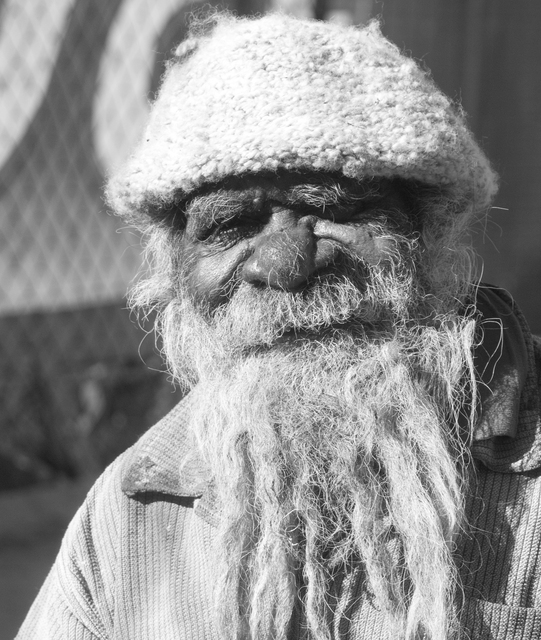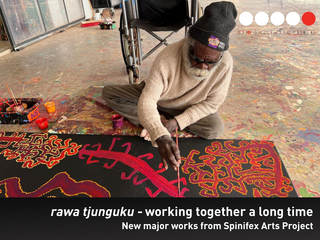SIMON HOGAN
Lingka
23-332 (2023)
Acrylic on Linen
200 x 230cm | 78.74 x 90.55in
Spinifex Artists
ENQUIRE
SIMON HOGAN
Lingka
22-253 (2022)
Acrylic on Linen
200 x 137cm | 78.74 x 53.94in
Spinifex Artists
ENQUIRE
SIMON HOGAN
Lingka
24-393 (2024)
Acrylic on Linen
200 x 137cm | 78.74 x 53.94in
Spinifex Artists
ENQUIRE
Simon Hogan was born circa 1930 in mid-western Spinifex between Paltju and Lingka. Simon’s exact age is unknown as dates of birth were estimated by the A.E.M. missionaries when the Spinifex people, on arrival at Cundeelee, were “sorted” into family groups, given English names and approximate dates of birth. During childhood two fathers, one born at Warakunu and the other at Munki raised Simon. Simon’s mother’s country is around Tjulya. The Spinifex people were a relatively discreet southern Pitjantjatjara tribal group with ties to the north and east that lived a fully traditional hunter-gatherer life until the late 1950’s to early 1960s when most people either walked in to Ooldea and Cundeelee or were taken by AEM missionaries to Cundeelee Mission.
As a late teenager or nyiingka living in seclusion from Aboriginal society prior to initiation into manhood, Simon and an older brother made an epic journey from the Spinifex lands to a Christian Mission at Mt. Margaret. He traveled there via the frontier mining towns of Laverton and Leonora. The older brother chose to stay at Mt. Margaret and Simon returned to the Great Victoria Desert and initiation into manhood.
Some time after initiation Simon traveled across the Serpentine Lakes into South Australia to find a wife. He married Inyika and they had two of their seven children in country before going to Cundeelee Mission around 1960. A second wife, Ngantiri, also traveled in with Simon’s family group. From 1995 Simon Hogan was a prominent member of a group of senior traditional owners from Spinifex country who lobbied the WA State Government for Native Title.
Although Simon spoke no English he was a confident, initiated Pitjantjatjara man who spoke to senior government officials regarding ownership of country and culture. Exclusive Native Title rights were granted to Simon Hogan and the Spinifex people in 2000 of over 55 000 sq kms of the Great Victoria Desert in WA. In 1997 the Spinifex people began painting with acrylic paints on canvas, painting traditional stories using this contemporary medium. Simon again took a leading working with intense concentration and focus to translate Tjukurpa (stories or mythologies) into public artworks. The Spinifex people also produced collaborative works two of which, men’s and women’s, were used in the preamble to the successful Spinifex Native Title claim.
Simon is an effusive individual who introduces himself as “Mr. Hogan” and will happily recount his many exhibition travels throughout Australia and the world. For over a decade he carried a photo of himself and Gough Whitlam in his wallet until the photo eventually disintegrated. The photo was taken during the 1998 Pila Nguru Native Title touring exhibition.
The Whitlams were invited to open the exhibition in Canberra. In 2009 Simon traveled to Linz, Austria to be an Artist in Residence during the 2009, Linz Cultural Capital of Europe Exposition. He is a tireless ambassador for Spinifex custom and culture. In 2015 well into his 80’s he travelled to London representing the Spinifex people at an exhibition at the British Museum, where he met with HRH Prince Charles.
Over the years Simon Hogan’s enthusiasm and focus for painting on linen has not diminished. His status as a painter in his own community and on a national and international level has steadily increased over these years making him one of the most sought after Spinifex artists. His works feature in many public and private collections.
Simon Hogan was born circa 1930 in mid-western Spinifex between Paltju and Lingka. Simon’s exact age is unknown as dates of birth were estimated by the A.E.M. missionaries when the Spinifex people, on arrival at Cundeelee, were “sorted” into family groups, given English names and approximate dates of birth. During childhood two fathers, one born at Warakunu and the other at Munki raised Simon. Simon’s mother’s country is around Tjulya. The Spinifex people were a relatively discreet southern Pitjantjatjara tribal group with ties to the north and east that lived a fully traditional hunter-gatherer life until the late 1950’s to early 1960s when most people either walked in to Ooldea and Cundeelee or were taken by AEM missionaries to Cundeelee Mission.
As a late teenager or nyiingka living in seclusion from Aboriginal society prior to initiation into manhood, Simon and an older brother made an epic journey from the Spinifex lands to a Christian Mission at Mt. Margaret. He traveled there via the frontier mining towns of Laverton and Leonora. The older brother chose to stay at Mt. Margaret and Simon returned to the Great Victoria Desert and initiation into manhood.
Some time after initiation Simon traveled across the Serpentine Lakes into South Australia to find a wife. He married Inyika and they had two of their seven children in country before going to Cundeelee Mission around 1960. A second wife, Ngantiri, also traveled in with Simon’s family group. From 1995 Simon Hogan was a prominent member of a group of senior traditional owners from Spinifex country who lobbied the WA State Government for Native Title.
Although Simon spoke no English he was a confident, initiated Pitjantjatjara man who spoke to senior government officials regarding ownership of country and culture. Exclusive Native Title rights were granted to Simon Hogan and the Spinifex people in 2000 of over 55 000 sq kms of the Great Victoria Desert in WA. In 1997 the Spinifex people began painting with acrylic paints on canvas, painting traditional stories using this contemporary medium. Simon again took a leading working with intense concentration and focus to translate Tjukurpa (stories or mythologies) into public artworks. The Spinifex people also produced collaborative works two of which, men’s and women’s, were used in the preamble to the successful Spinifex Native Title claim.
Simon is an effusive individual who introduces himself as “Mr. Hogan” and will happily recount his many exhibition travels throughout Australia and the world. For over a decade he carried a photo of himself and Gough Whitlam in his wallet until the photo eventually disintegrated. The photo was taken during the 1998 Pila Nguru Native Title touring exhibition.
The Whitlams were invited to open the exhibition in Canberra. In 2009 Simon traveled to Linz, Austria to be an Artist in Residence during the 2009, Linz Cultural Capital of Europe Exposition. He is a tireless ambassador for Spinifex custom and culture. In 2015 well into his 80’s he travelled to London representing the Spinifex people at an exhibition at the British Museum, where he met with HRH Prince Charles.
Over the years Simon Hogan’s enthusiasm and focus for painting on linen has not diminished. His status as a painter in his own community and on a national and international level has steadily increased over these years making him one of the most sought after Spinifex artists. His works feature in many public and private collections.
![Australian Indigenous (Aboriginal and Torres Strait Islander) artwork by SIMON HOGAN of Spinifex Artists. The title is Lingka. [23-332] (Acrylic on Linen)](https://media.redotgallery.com/stockroom/gallery/l/artwork/s/lingka-6280-MEDIUM-1.jpg)
![Australian Indigenous (Aboriginal and Torres Strait Islander) artwork by SIMON HOGAN of Spinifex Artists. The title is Lingka. [22-253] (Acrylic on Linen)](https://media.redotgallery.com/stockroom/gallery/l/artwork/s/lingka-6174-MEDIUM-3.webp)
![Australian Indigenous (Aboriginal and Torres Strait Islander) artwork by SIMON HOGAN of Spinifex Artists. The title is Lingka. [24-393] (Acrylic on Linen)](https://media.redotgallery.com/stockroom/gallery/l/artwork/s/lingka-6269-MEDIUM-1.jpg)

